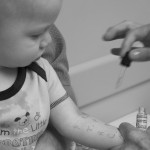Tests Your Doctor May Consider
When an FPIES evaluation process begins, the physician may consider using a variety of tests to help rule in or rule out a diagnosis of FPIES. Unfortunately, there are no blood tests or biopsies that can be done to confirm the diagnosis, as FPIES is considered a clinical diagnosis (diagnosis is based on individual's history of symptoms and tests that rule out conditions that may present similarly). Below, you will find a basic explanation of some of these tests. Be sure to consult with your or your loved one's practitioner about individualized needs as they relate to each test!
Atopy Patch Testing
A diagnostic tool used by some allergists to test reactivity for Non-IgE allergies by applying small disks with the food allergen placed under it on the surface of the skin (often the back). APT has not been universally accepted at this time and should be considered for use as a research tool rather than a standard test; it is not commonly used. Please see section 4.2.2.5 of the 2010 Guidelines for the Diagnosis and Management of Food Allergy in the United States for more details on patch testing in allergies. More
Colonoscopy

A procedure performed by a gastroenterologist to exam the lower colon; this may be ordered to rule in/rule out specific medical conditions. More
Complete Blood Count

A Complete Blood Count (CBC) measures specific components in the blood and its results can help a physician to rule in/rule out various medical conditions.
Endoscopy (Upper)

A procedure performed by a gastroenterologist to exam the upper gastrointestinal tract with a small scope: esophagus, stomach, upper small intestines; this may ordered to rule in/rule out specific medical conditions. More
Food Trial
A food trial is a term used to refer to the process of offering a specific single-ingredient food to an infant/child for the first time. Generally, the food is given for a set period of days (i.e. for a full week, etc.) and in increasingly larger amounts with each day of the trial. The goal is to offer a full, age-appropriate serving of the food on the final day of the trial. If the infant/child does not appear symptomatic in relation to the food by the end of the trial, the food is generally considered safe. An infant/child’s doctor can help parents to determine an appropriate food trial length for him/her based on his/her age and reaction history.
Oral Food Challenge

A test, to be completed under medical supervision, to find out if a food is tolerated to either: a) confirm presence of allergy to suspected food; or b) to assess if allergy has been outgrown. More
RAST
An acronym that stands for radioallergosorbent test (also known as the Allergen–specific IgE antibody test), this is a blood test done to evaluate IgE antibody responses in the blood in regards to specific allergens. A detailed description can be found in section 4.2.2.4 of the 2010 Guidelines for the Diagnosis and Management of Food Allergy in the United States. More
Skin Prick Testing

A test performed in the allergist’s office to aid in detecting IgE allergies. A description of this test can be found in section 4.2.2.1 of the 2010 Guidelines for the Diagnosis and Management of Food Allergy in the United States. More
Sigmoidoscopy

Procedure performed by a gastroenterologist to exam the lower colon; this may be ordered to rule in/rule out specific medical conditions. More
Upper GI Series
A test ordered by a doctor to rule out anatomical abnormalities in the upper gastrointestinal (GI) system that may be contributing to symptoms. The patient ingests a barium solution and undergoes a series of x-rays to exam various components of the upper GI system. More

Page Published: July 5, 2012. Last Update: August 4, 2022. Copyright (c) 2012, The FPIES Foundation